深入源码分析,缓存之王 Caffeine 为何这么猛?
点击上方 泥瓦匠 关注我!
老家浙江东海边,靠海吃海,目前经营一个小品牌,让普通人吃到最新鲜的海鲜。有兴趣可以点击了解:《浙里有渔,鲜人一步!》???
Caffeine[1]是一个高性能,高命中率,低内存占用,near optimal 的本地缓存,简单来说它是 Guava Cache 的优化加强版,有些文章把 Caffeine 称为“新一代的缓存”、“现代缓存之王”。
本文将重点讲解 Caffeine 的高性能设计,以及对应部分的源码分析。
与 Guava Cache 比较
如果你对 Guava Cache 还不理解的话,可以点击这里[2]来看一下我之前写过关于 Guava Cache 的文章。
大家都知道,Spring5 即将放弃掉 Guava Cache 作为缓存机制,而改用 Caffeine 作为新的本地 Cache 的组件,这对于 Caffeine 来说是一个很大的肯定。为什么 Spring 会这样做呢?其实在 Caffeine 的Benchmarks[3]里给出了好靓仔的数据,对读和写的场景,还有跟其他几个缓存工具进行了比较,Caffeine 的性能都表现很突出。
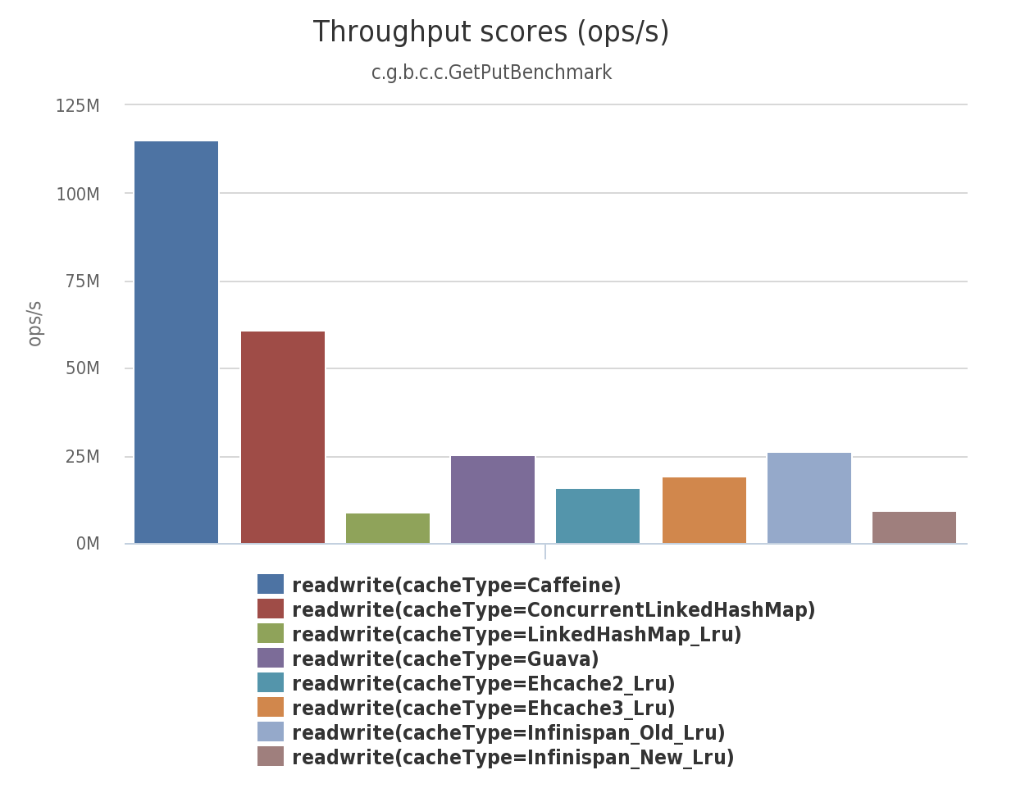
使用 Caffeine
Caffeine 为了方便大家使用以及从 Guava Cache 切换过来(很有针对性啊~),借鉴了 Guava Cache 大部分的概念(诸如核心概念Cache、LoadingCache、CacheLoader、CacheBuilder等等),对于 Caffeine 的理解只要把它当作 Guava Cache 就可以了。
使用上,大家只要把 Caffeine 的包引进来,然后换一下 cache 的实现类,基本应该就没问题了。这对与已经使用过 Guava Cache 的同学来说没有任何难度,甚至还有一点熟悉的味道,如果你之前没有使用过 Guava Cache,可以查看 Caffeine 的官方 API 说明文档[4],其中Population,Eviction,Removal,Refresh,Statistics,Cleanup,Policy等等这些特性都是跟 Guava Cache 基本一样的。
下面给出一个例子说明怎样创建一个 Cache:
private static LoadingCache cache = Caffeine.newBuilder()
//最大个数限制
.maximumSize(256L)
//初始化容量
.initialCapacity(1)
//访问后过期(包括读和写)
.expireAfterAccess(2, TimeUnit.DAYS)
//写后过期
.expireAfterWrite(2, TimeUnit.HOURS)
//写后自动异步刷新
.refreshAfterWrite(1, TimeUnit.HOURS)
//记录下缓存的一些统计数据,例如命中率等
.recordStats()
//cache对缓存写的通知回调
.writer(new CacheWriter() {
@Override
public void write(@NonNull Object key, @NonNull Object value) {
log.info("key={}, CacheWriter write", key);
}
@Override
public void delete(@NonNull Object key, @Nullable Object value, @NonNull RemovalCause cause) {
log.info("key={}, cause={}, CacheWriter delete", key, cause);
}
})
//使用CacheLoader创建一个LoadingCache
.build(new CacheLoader() {
//同步加载数据
@Nullable
@Override
public String load(@NonNull String key) throws Exception {
return "value_" + key;
}
//异步加载数据
@Nullable
@Override
public String reload(@NonNull String key, @NonNull String oldValue) throws Exception {
return "value_" + key;
}
});
更多从 Guava Cache 迁移过来的使用说明,请看这里[5]
Caffeine 的高性能设计
判断一个缓存的好坏最核心的指标就是命中率,影响缓存命中率有很多因素,包括业务场景、淘汰策略、清理策略、缓存容量等等。如果作为本地缓存, 它的性能的情况,资源的占用也都是一个很重要的指标。下面
我们来看看 Caffeine 在这几个方面是怎么着手的,如何做优化的。
(注:本文不会分析 Caffeine 全部源码,只会对核心设计的实现进行分析,但我建议读者把 Caffeine 的源码都涉猎一下,有个 overview 才能更好理解本文。如果你看过 Guava Cache 的源码也行,代码的数据结构和处理逻辑很类似的。
源码基于:caffeine-2.8.0.jar)
W-TinyLFU 整体设计
上面说到淘汰策略是影响缓存命中率的因素之一,一般比较简单的缓存就会直接用到 LFU(Least Frequently Used,即最不经常使用) 或者LRU(Least Recently Used,即最近最少使用) ,而 Caffeine 就是使用了 W-TinyLFU 算法。
W-TinyLFU 看名字就能大概猜出来,它是 LFU 的变种,也是一种缓存淘汰算法。那为什么要使用 W-TinyLFU 呢?
LRU 和 LFU 的缺点
LRU 实现简单,在一般情况下能够表现出很好的命中率,是一个“性价比”很高的算法,平时也很常用。虽然 LRU 对突发性的稀疏流量(sparse bursts)表现很好,但同时也会产生缓存污染,举例来说,如果偶然性的要对全量数据进行遍历,那么“历史访问记录”就会被刷走,造成污染。 如果数据的分布在一段时间内是固定的话,那么 LFU 可以达到最高的命中率。但是 LFU 有两个缺点,第一,它需要给每个记录项维护频率信息,每次访问都需要更新,这是个巨大的开销;第二,对突发性的稀疏流量无力,因为前期经常访问的记录已经占用了缓存,偶然的流量不太可能会被保留下来,而且过去的一些大量被访问的记录在将来也不一定会使用上,这样就一直把“坑”占着了。
无论 LRU 还是 LFU 都有其各自的缺点,不过,现在已经有很多针对其缺点而改良、优化出来的变种算法。
TinyLFU
TinyLFU 就是其中一个优化算法,它是专门为了解决 LFU 上述提到的两个问题而被设计出来的。
解决第一个问题是采用了 Count–Min Sketch 算法。
解决第二个问题是让记录尽量保持相对的“新鲜”(Freshness Mechanism),并且当有新的记录插入时,可以让它跟老的记录进行“PK”,输者就会被淘汰,这样一些老的、不再需要的记录就会被剔除。
下图是 TinyLFU 设计图(来自官方)
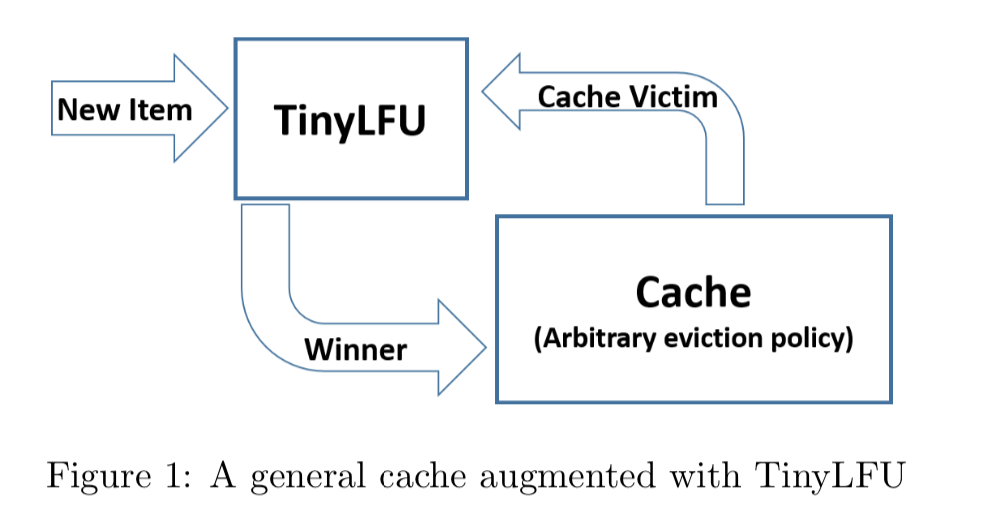
统计频率 Count–Min Sketch 算法
如何对一个 key 进行统计,但又可以节省空间呢?(不是简单的使用HashMap,这太消耗内存了),注意哦,不需要精确的统计,只需要一个近似值就可以了,怎么样,这样场景是不是很熟悉,如果你是老司机,或许已经联想到布隆过滤器(Bloom Filter)的应用了。
没错,将要介绍的 Count–Min Sketch 的原理跟 Bloom Filter 一样,只不过 Bloom Filter 只有 0 和 1 的值,那么你可以把 Count–Min Sketch 看作是“数值”版的 Bloom Filter。
更多关于 Count–Min Sketch 的介绍请自行搜索。
在 TinyLFU 中,近似频率的统计如下图所示:
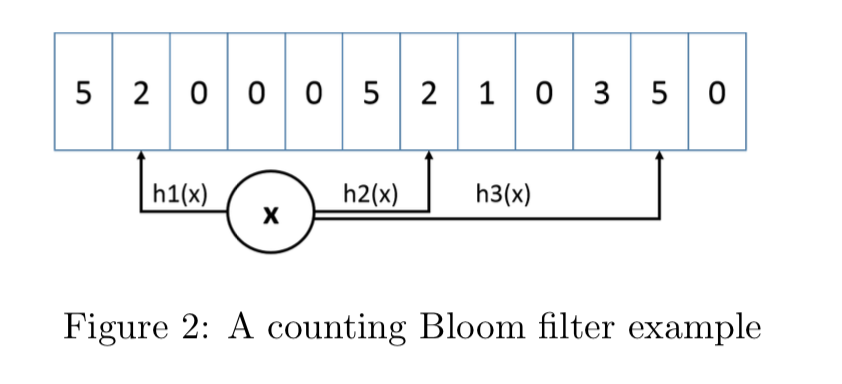
对一个 key 进行多次 hash 函数后,index 到多个数组位置后进行累加,查询时取多个值中的最小值即可。
Caffeine 对这个算法的实现在FrequencySketch类。但 Caffeine 对此有进一步的优化,例如 Count–Min Sketch 使用了二维数组,Caffeine 只是用了一个一维的数组;再者,如果是数值类型的话,这个数需要用 int 或 long 来存储,但是 Caffeine 认为缓存的访问频率不需要用到那么大,只需要 15 就足够,一般认为达到 15 次的频率算是很高的了,而且 Caffeine 还有另外一个机制来使得这个频率进行衰退减半(下面就会讲到)。如果最大是 15 的话,那么只需要 4 个 bit 就可以满足了,一个 long 有 64bit,可以存储 16 个这样的统计数,Caffeine 就是这样的设计,使得存储效率提高了 16 倍。
Caffeine 对缓存的读写(afterRead和afterWrite方法)都会调用onAccesss 方法,而onAccess方法里有一句:
frequencySketch().increment(key);
这句就是追加记录的频率,下面我们看看具体实现
//FrequencySketch的一些属性
//种子数
static final long[] SEED = { // A mixture of seeds from FNV-1a, CityHash, and Murmur3
0xc3a5c85c97cb3127L, 0xb492b66fbe98f273L, 0x9ae16a3b2f90404fL, 0xcbf29ce484222325L};
static final long RESET_MASK = 0x7777777777777777L;
static final long ONE_MASK = 0x1111111111111111L;
int sampleSize;
//为了快速根据hash值得到table的index值的掩码
//table的长度size一般为2的n次方,而tableMask为size-1,这样就可以通过&操作来模拟取余操作,速度快很多,老司机都知道
int tableMask;
//存储数据的一维long数组
long[] table;
int size;
/**
* Increments the popularity of the element if it does not exceed the maximum (15). The popularity
* of all elements will be periodically down sampled when the observed events exceeds a threshold.
* This process provides a frequency aging to allow expired long term entries to fade away.
*
* @param e the element to add
*/
public void increment(@NonNull E e) {
if (isNotInitialized()) {
return;
}
//根据key的hashCode通过一个哈希函数得到一个hash值
//本来就是hashCode了,为什么还要再做一次hash?怕原来的hashCode不够均匀分散,再打散一下。
int hash = spread(e.hashCode());
//这句光看有点难理解
//就如我刚才说的,Caffeine把一个long的64bit划分成16个等分,每一等分4个bit。
//这个start就是用来定位到是哪一个等分的,用hash值低两位作为随机数,再左移2位,得到一个小于16的值
int start = (hash & 3) << 2;
//indexOf方法的意思就是,根据hash值和不同种子得到table的下标index
//这里通过四个不同的种子,得到四个不同的下标index
int index0 = indexOf(hash, 0);
int index1 = indexOf(hash, 1);
int index2 = indexOf(hash, 2);
int index3 = indexOf(hash, 3);
//根据index和start(+1, +2, +3)的值,把table[index]对应的等分追加1
//这个incrementAt方法有点难理解,看我下面的解释
boolean added = incrementAt(index0, start);
added |= incrementAt(index1, start + 1);
added |= incrementAt(index2, start + 2);
added |= incrementAt(index3, start + 3);
//这个reset等下说
if (added && (++size == sampleSize)) {
reset();
}
}
/**
* Increments the specified counter by 1 if it is not already at the maximum value (15).
*
* @param i the table index (16 counters)
* @param j the counter to increment
* @return if incremented
*/
boolean incrementAt(int i, int j) {
//这个j表示16个等分的下标,那么offset就是相当于在64位中的下标(这个自己想想)
int offset = j << 2;
//上面提到Caffeine把频率统计最大定为15,即0xfL
//mask就是在64位中的掩码,即1111后面跟很多个0
long mask = (0xfL << offset);
//如果&的结果不等于15,那么就追加1。等于15就不会再加了
if ((table[i] & mask) != mask) {
table[i] += (1L << offset);
return true;
}
return false;
}
/**
* Returns the table index for the counter at the specified depth.
*
* @param item the element's hash
* @param i the counter depth
* @return the table index
*/
int indexOf(int item, int i) {
long hash = SEED[i] * item;
hash += hash >>> 32;
return ((int) hash) & tableMask;
}
/**
* Applies a supplemental hash function to a given hashCode, which defends against poor quality
* hash functions.
*/
int spread(int x) {
x = ((x >>> 16) ^ x) * 0x45d9f3b;
x = ((x >>> 16) ^ x) * 0x45d9f3b;
return (x >>> 16) ^ x;
}
知道了追加方法,那么读取方法frequency就很容易理解了。
/**
* Returns the estimated number of occurrences of an element, up to the maximum (15).
*
* @param e the element to count occurrences of
* @return the estimated number of occurrences of the element; possibly zero but never negative
*/
@NonNegative
public int frequency(@NonNull E e) {
if (isNotInitialized()) {
return 0;
}
//得到hash值,跟上面一样
int hash = spread(e.hashCode());
//得到等分的下标,跟上面一样
int start = (hash & 3) << 2;
int frequency = Integer.MAX_VALUE;
//循环四次,分别获取在table数组中不同的下标位置
for (int i = 0; i < 4; i++) {
int index = indexOf(hash, i);
//这个操作就不多说了,其实跟上面incrementAt是一样的,定位到table[index] + 等分的位置,再根据mask取出计数值
int count = (int) ((table[index] >>> ((start + i) << 2)) & 0xfL);
//取四个中的较小值
frequency = Math.min(frequency, count);
}
return frequency;
}
通过代码和注释或者读者可能难以理解,下图是我画出来帮助大家理解的结构图。
注意紫色虚线框,其中蓝色小格就是需要计算的位置:
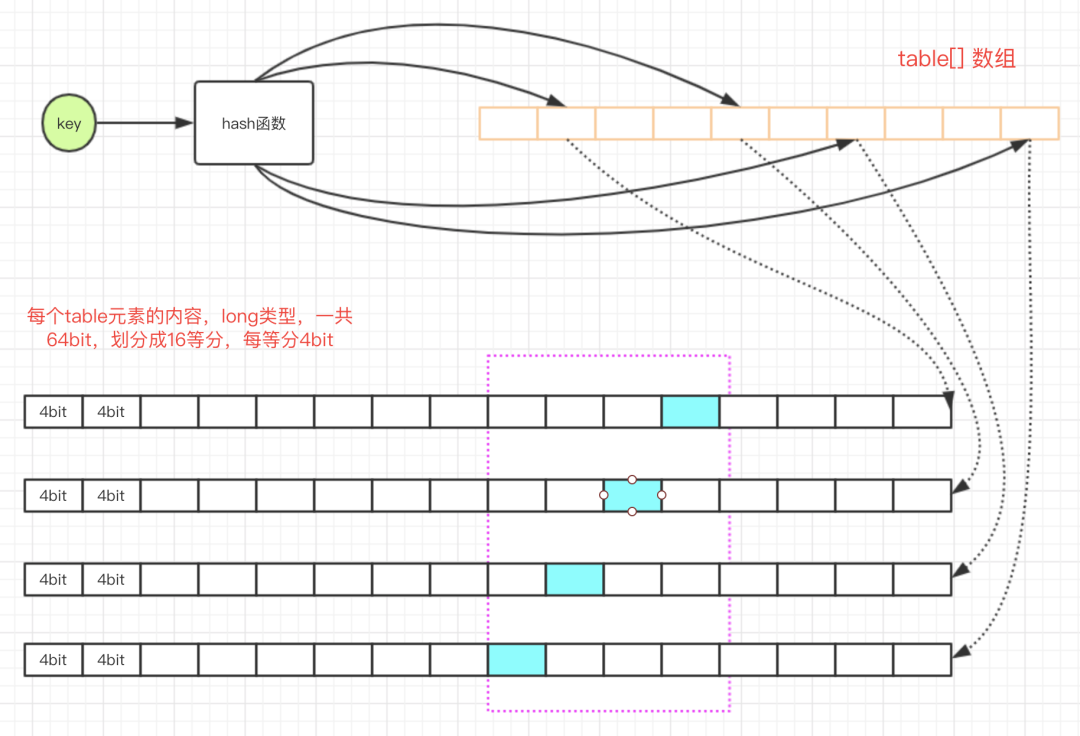
保新机制
为了让缓存保持“新鲜”,剔除掉过往频率很高但之后不经常的缓存,Caffeine 有一个 Freshness Mechanism。做法很简答,就是当整体的统计计数(当前所有记录的频率统计之和,这个数值内部维护)达到某一个值时,那么所有记录的频率统计除以 2。
从上面的代码
//size变量就是所有记录的频率统计之,即每个记录加1,这个size都会加1
//sampleSize一个阈值,从FrequencySketch初始化可以看到它的值为maximumSize的10倍
if (added && (++size == sampleSize)) {
reset();
}
看到reset方法就是做这个事情
/** Reduces every counter by half of its original value. */
void reset() {
int count = 0;
for (int i = 0; i < table.length; i++) {
count += Long.bitCount(table[i] & ONE_MASK);
table[i] = (table[i] >>> 1) & RESET_MASK;
}
size = (size >>> 1) - (count >>> 2);
}
关于这个 reset 方法,为什么是除以 2,而不是其他,及其正确性,在最下面的参考资料的 TinyLFU 论文中 3.3 章节给出了数学证明,大家有兴趣可以看看。
增加一个 Window?
Caffeine 通过测试发现 TinyLFU 在面对突发性的稀疏流量(sparse bursts)时表现很差,因为新的记录(new items)还没来得及建立足够的频率就被剔除出去了,这就使得命中率下降。
于是 Caffeine 设计出一种新的 policy,即 Window Tiny LFU(W-TinyLFU),并通过实验和实践发现 W-TinyLFU 比 TinyLFU 表现的更好。
W-TinyLFU 的设计如下所示(两图等价):
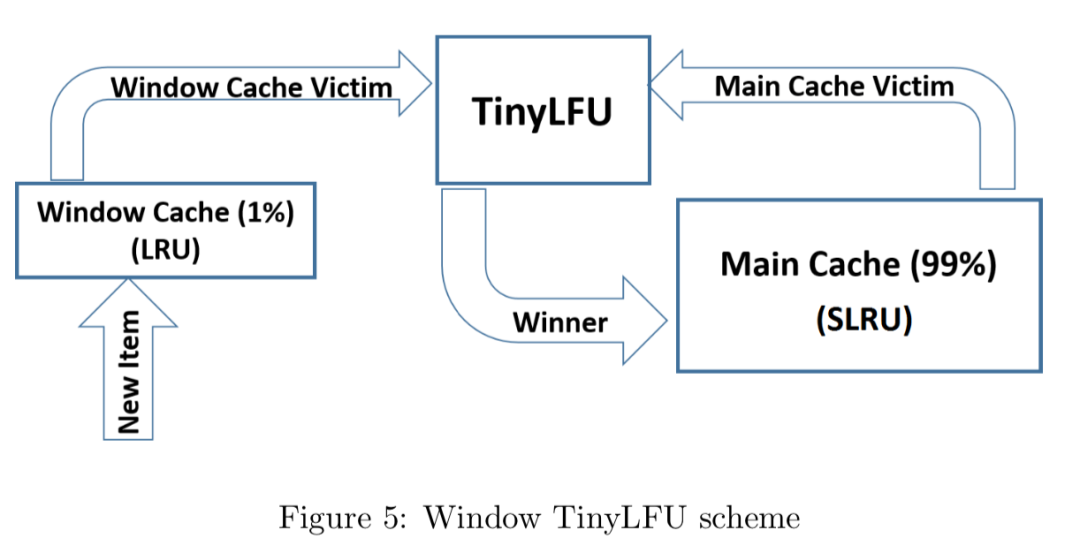

它主要包括两个缓存模块,主缓存是 SLRU(Segmented LRU,即分段 LRU),SLRU 包括一个名为 protected 和一个名为 probation 的缓存区。通过增加一个缓存区(即 Window Cache),当有新的记录插入时,会先在 window 区呆一下,就可以避免上述说的 sparse bursts 问题。
淘汰策略(eviction policy)
当 window 区满了,就会根据 LRU 把 candidate(即淘汰出来的元素)放到 probation 区,如果 probation 区也满了,就把 candidate 和 probation 将要淘汰的元素 victim,两个进行“PK”,胜者留在 probation,输者就要被淘汰了。
而且经过实验发现当 window 区配置为总容量的 1%,剩余的 99%当中的 80%分给 protected 区,20%分给 probation 区时,这时整体性能和命中率表现得最好,所以 Caffeine 默认的比例设置就是这个。
不过这个比例 Caffeine 会在运行时根据统计数据(statistics)去动态调整,如果你的应用程序的缓存随着时间变化比较快的话,那么增加 window 区的比例可以提高命中率,相反缓存都是比较固定不变的话,增加 Main Cache 区(protected 区 +probation 区)的比例会有较好的效果。
下面我们看看上面说到的淘汰策略是怎么实现的:
一般缓存对读写操作后都有后续的一系列“维护”操作,Caffeine 也不例外,这些操作都在maintenance方法,我们将要说到的淘汰策略也在里面。
这方法比较重要,下面也会提到,所以这里只先说跟“淘汰策略”有关的evictEntries和climb。
/**
* Performs the pending maintenance work and sets the state flags during processing to avoid
* excess scheduling attempts. The read buffer, write buffer, and reference queues are
* drained, followed by expiration, and size-based eviction.
*
* @param task an additional pending task to run, or {@code null} if not present
*/
@GuardedBy("evictionLock")
void maintenance(@Nullable Runnable task) {
lazySetDrainStatus(PROCESSING_TO_IDLE);
try {
drainReadBuffer();
drainWriteBuffer();
if (task != null) {
task.run();
}
drainKeyReferences();
drainValueReferences();
expireEntries();
//把符合条件的记录淘汰掉
evictEntries();
//动态调整window区和protected区的大小
climb();
} finally {
if ((drainStatus() != PROCESSING_TO_IDLE) || !casDrainStatus(PROCESSING_TO_IDLE, IDLE)) {
lazySetDrainStatus(REQUIRED);
}
}
}
//最大的个数限制
long maximum;
//当前的个数
long weightedSize;
//window区的最大限制
long windowMaximum;
//window区当前的个数
long windowWeightedSize;
//protected区的最大限制
long mainProtectedMaximum;
//protected区当前的个数
long mainProtectedWeightedSize;
//下一次需要调整的大小(还需要进一步计算)
double stepSize;
//window区需要调整的大小
long adjustment;
//命中计数
int hitsInSample;
//不命中的计数
int missesInSample;
//上一次的缓存命中率
double previousSampleHitRate;
final FrequencySketch sketch;
//window区的LRU queue(FIFO)
final AccessOrderDeque> accessOrderWindowDeque;
//probation区的LRU queue(FIFO)
final AccessOrderDeque> accessOrderProbationDeque;
//protected区的LRU queue(FIFO)
final AccessOrderDeque> accessOrderProtectedDeque;
以及默认比例设置(意思看注释)
/** The initial percent of the maximum weighted capacity dedicated to the main space. */
static final double PERCENT_MAIN = 0.99d;
/** The percent of the maximum weighted capacity dedicated to the main's protected space. */
static final double PERCENT_MAIN_PROTECTED = 0.80d;
/** The difference in hit rates that restarts the climber. */
static final double HILL_CLIMBER_RESTART_THRESHOLD = 0.05d;
/** The percent of the total size to adapt the window by. */
static final double HILL_CLIMBER_STEP_PERCENT = 0.0625d;
/** The rate to decrease the step size to adapt by. */
static final double HILL_CLIMBER_STEP_DECAY_RATE = 0.98d;
/** The maximum number of entries that can be transfered between queues. */
重点来了,evictEntries和climb方法:
/** Evicts entries if the cache exceeds the maximum. */
@GuardedBy("evictionLock")
void evictEntries() {
if (!evicts()) {
return;
}
//淘汰window区的记录
int candidates = evictFromWindow();
//淘汰Main区的记录
evictFromMain(candidates);
}
/**
* Evicts entries from the window space into the main space while the window size exceeds a
* maximum.
*
* @return the number of candidate entries evicted from the window space
*/
//根据W-TinyLFU,新的数据都会无条件的加到admission window
//但是window是有大小限制,所以要“定期”做一下“维护”
@GuardedBy("evictionLock")
int evictFromWindow() {
int candidates = 0;
//查看window queue的头部节点
Node node = accessOrderWindowDeque().peek();
//如果window区超过了最大的限制,那么就要把“多出来”的记录做处理
while (windowWeightedSize() > windowMaximum()) {
// The pending operations will adjust the size to reflect the correct weight
if (node == null) {
break;
}
//下一个节点
Node next = node.getNextInAccessOrder();
if (node.getWeight() != 0) {
//把node定位在probation区
node.makeMainProbation();
//从window区去掉
accessOrderWindowDeque().remove(node);
//加入到probation queue,相当于把节点移动到probation区(晋升了)
accessOrderProbationDeque().add(node);
candidates++;
//因为移除了一个节点,所以需要调整window的size
setWindowWeightedSize(windowWeightedSize() - node.getPolicyWeight());
}
//处理下一个节点
node = next;
}
return candidates;
}
evictFromMain方法:
/**
* Evicts entries from the main space if the cache exceeds the maximum capacity. The main space
* determines whether admitting an entry (coming from the window space) is preferable to retaining
* the eviction policy's victim. This is decision is made using a frequency filter so that the
* least frequently used entry is removed.
*
* The window space candidates were previously placed in the MRU position and the eviction
* policy's victim is at the LRU position. The two ends of the queue are evaluated while an
* eviction is required. The number of remaining candidates is provided and decremented on
* eviction, so that when there are no more candidates the victim is evicted.
*
* @param candidates the number of candidate entries evicted from the window space
*/
//根据W-TinyLFU,从window晋升过来的要跟probation区的进行“PK”,胜者才能留下
@GuardedBy("evictionLock")
void evictFromMain(int candidates) {
int victimQueue = PROBATION;
//victim是probation queue的头部
Node victim = accessOrderProbationDeque().peekFirst();
//candidate是probation queue的尾部,也就是刚从window晋升来的
Node candidate = accessOrderProbationDeque().peekLast();
//当cache不够容量时才做处理
while (weightedSize() > maximum()) {
// Stop trying to evict candidates and always prefer the victim
if (candidates == 0) {
candidate = null;
}
//对candidate为null且victim为bull的处理
if ((candidate == null) && (victim == null)) {
if (victimQueue == PROBATION) {
victim = accessOrderProtectedDeque().peekFirst();
victimQueue = PROTECTED;
continue;
} else if (victimQueue == PROTECTED) {
victim = accessOrderWindowDeque().peekFirst();
victimQueue = WINDOW;
continue;
}
// The pending operations will adjust the size to reflect the correct weight
break;
}
//对节点的weight为0的处理
if ((victim != null) && (victim.getPolicyWeight() == 0)) {
victim = victim.getNextInAccessOrder();
continue;
} else if ((candidate != null) && (candidate.getPolicyWeight() == 0)) {
candidate = candidate.getPreviousInAccessOrder();
candidates--;
continue;
}
// Evict immediately if only one of the entries is present
if (victim == null) {
@SuppressWarnings("NullAway")
Node previous = candidate.getPreviousInAccessOrder();
Node evict = candidate;
candidate = previous;
candidates--;
evictEntry(evict, RemovalCause.SIZE, 0L);
continue;
} else if (candidate == null) {
Node evict = victim;
victim = victim.getNextInAccessOrder();
evictEntry(evict, RemovalCause.SIZE, 0L);
continue;
}
// Evict immediately if an entry was collected
K victimKey = victim.getKey();
K candidateKey = candidate.getKey();
if (victimKey == null) {
@NonNull Node evict = victim;
victim = victim.getNextInAccessOrder();
evictEntry(evict, RemovalCause.COLLECTED, 0L);
continue;
} else if (candidateKey == null) {
candidates--;
@NonNull Node evict = candidate;
candidate = candidate.getPreviousInAccessOrder();
evictEntry(evict, RemovalCause.COLLECTED, 0L);
continue;
}
//放不下的节点直接处理掉
if (candidate.getPolicyWeight() > maximum()) {
candidates--;
Node evict = candidate;
candidate = candidate.getPreviousInAccessOrder();
evictEntry(evict, RemovalCause.SIZE, 0L);
continue;
}
//根据节点的统计频率frequency来做比较,看看要处理掉victim还是candidate
//admit是具体的比较规则,看下面
candidates--;
//如果candidate胜出则淘汰victim
if (admit(candidateKey, victimKey)) {
Node evict = victim;
victim = victim.getNextInAccessOrder();
evictEntry(evict, RemovalCause.SIZE, 0L);
candidate = candidate.getPreviousInAccessOrder();
} else {
//如果是victim胜出,则淘汰candidate
Node evict = candidate;
candidate = candidate.getPreviousInAccessOrder();
evictEntry(evict, RemovalCause.SIZE, 0L);
}
}
}
/**
* Determines if the candidate should be accepted into the main space, as determined by its
* frequency relative to the victim. A small amount of randomness is used to protect against hash
* collision attacks, where the victim's frequency is artificially raised so that no new entries
* are admitted.
*
* @param candidateKey the key for the entry being proposed for long term retention
* @param victimKey the key for the entry chosen by the eviction policy for replacement
* @return if the candidate should be admitted and the victim ejected
*/
@GuardedBy("evictionLock")
boolean admit(K candidateKey, K victimKey) {
//分别获取victim和candidate的统计频率
//frequency这个方法的原理和实现上面已经解释了
int victimFreq = frequencySketch().frequency(victimKey);
int candidateFreq = frequencySketch().frequency(candidateKey);
//谁大谁赢
if (candidateFreq > victimFreq) {
return true;
//如果相等,candidate小于5都当输了
} else if (candidateFreq <= 5) {
// The maximum frequency is 15 and halved to 7 after a reset to age the history. An attack
// exploits that a hot candidate is rejected in favor of a hot victim. The threshold of a warm
// candidate reduces the number of random acceptances to minimize the impact on the hit rate.
return false;
}
//如果相等且candidate大于5,则随机淘汰一个
int random = ThreadLocalRandom.current().nextInt();
return ((random & 127) == 0);
}
climb方法主要是用来调整 window size 的,使得 Caffeine 可以适应你的应用类型(如 OLAP 或 OLTP)表现出最佳的命中率。
下图是官方测试的数据:
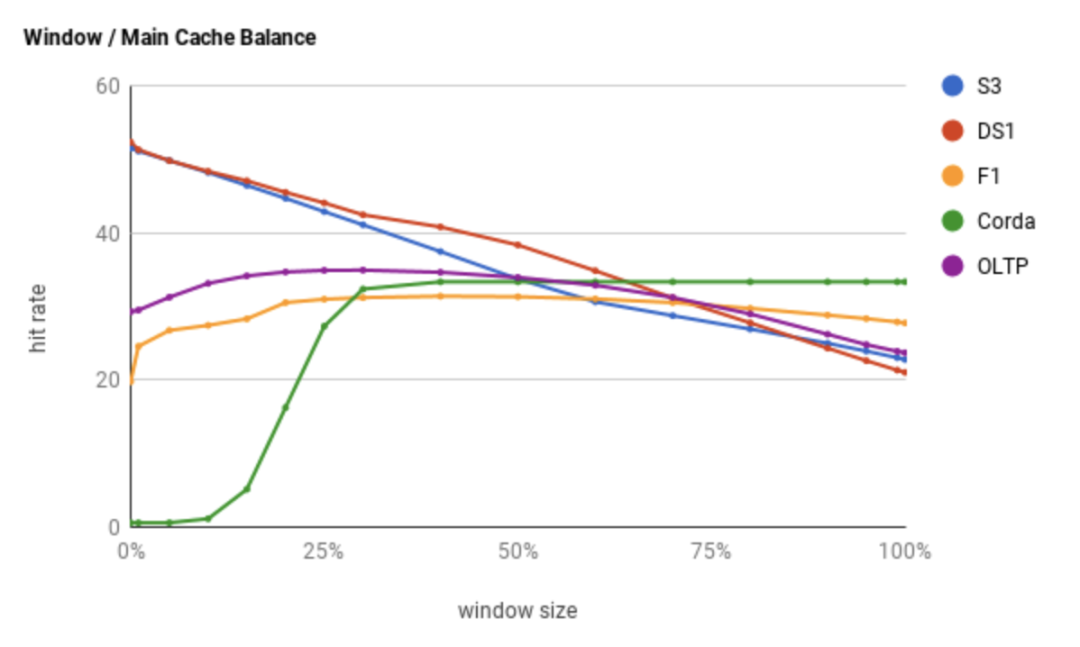
我们看看 window size 的调整是怎么实现的。
调整时用到的默认比例数据:
//与上次命中率之差的阈值
static final double HILL_CLIMBER_RESTART_THRESHOLD = 0.05d;
//步长(调整)的大小(跟最大值maximum的比例)
static final double HILL_CLIMBER_STEP_PERCENT = 0.0625d;
//步长的衰减比例
static final double HILL_CLIMBER_STEP_DECAY_RATE = 0.98d;
/** Adapts the eviction policy to towards the optimal recency / frequency configuration. */
//climb方法的主要作用就是动态调整window区的大小(相应的,main区的大小也会发生变化,两个之和为100%)。
//因为区域的大小发生了变化,那么区域内的数据也可能需要发生相应的移动。
@GuardedBy("evictionLock")
void climb() {
if (!evicts()) {
return;
}
//确定window需要调整的大小
determineAdjustment();
//如果protected区有溢出,把溢出部分移动到probation区。因为下面的操作有可能需要调整到protected区。
demoteFromMainProtected();
long amount = adjustment();
if (amount == 0) {
return;
} else if (amount > 0) {
//增加window的大小
increaseWindow();
} else {
//减少window的大小
decreaseWindow();
}
}
下面分别展开每个方法来解释:
/** Calculates the amount to adapt the window by and sets {@link #adjustment()} accordingly. */
@GuardedBy("evictionLock")
void determineAdjustment() {
//如果frequencySketch还没初始化,则返回
if (frequencySketch().isNotInitialized()) {
setPreviousSampleHitRate(0.0);
setMissesInSample(0);
setHitsInSample(0);
return;
}
//总请求量 = 命中 + miss
int requestCount = hitsInSample() + missesInSample();
//没达到sampleSize则返回
//默认下sampleSize = 10 * maximum。用sampleSize来判断缓存是否足够”热“。
if (requestCount < frequencySketch().sampleSize) {
return;
}
//命中率的公式 = 命中 / 总请求
double hitRate = (double) hitsInSample() / requestCount;
//命中率的差值
double hitRateChange = hitRate - previousSampleHitRate();
//本次调整的大小,是由命中率的差值和上次的stepSize决定的
double amount = (hitRateChange >= 0) ? stepSize() : -stepSize();
//下次的调整大小:如果命中率的之差大于0.05,则重置为0.065 * maximum,否则按照0.98来进行衰减
double nextStepSize = (Math.abs(hitRateChange) >= HILL_CLIMBER_RESTART_THRESHOLD)
? HILL_CLIMBER_STEP_PERCENT * maximum() * (amount >= 0 ? 1 : -1)
: HILL_CLIMBER_STEP_DECAY_RATE * amount;
setPreviousSampleHitRate(hitRate);
setAdjustment((long) amount);
setStepSize(nextStepSize);
setMissesInSample(0);
setHitsInSample(0);
}
/** Transfers the nodes from the protected to the probation region if it exceeds the maximum. */
//这个方法比较简单,减少protected区溢出的部分
@GuardedBy("evictionLock")
void demoteFromMainProtected() {
long mainProtectedMaximum = mainProtectedMaximum();
long mainProtectedWeightedSize = mainProtectedWeightedSize();
if (mainProtectedWeightedSize <= mainProtectedMaximum) {
return;
}
for (int i = 0; i < QUEUE_TRANSFER_THRESHOLD; i++) {
if (mainProtectedWeightedSize <= mainProtectedMaximum) {
break;
}
Node demoted = accessOrderProtectedDeque().poll();
if (demoted == null) {
break;
}
demoted.makeMainProbation();
accessOrderProbationDeque().add(demoted);
mainProtectedWeightedSize -= demoted.getPolicyWeight();
}
setMainProtectedWeightedSize(mainProtectedWeightedSize);
}
/**
* Increases the size of the admission window by shrinking the portion allocated to the main
* space. As the main space is partitioned into probation and protected regions (80% / 20%), for
* simplicity only the protected is reduced. If the regions exceed their maximums, this may cause
* protected items to be demoted to the probation region and probation items to be demoted to the
* admission window.
*/
//增加window区的大小,这个方法比较简单,思路就像我上面说的
@GuardedBy("evictionLock")
void increaseWindow() {
if (mainProtectedMaximum() == 0) {
return;
}
long quota = Math.min(adjustment(), mainProtectedMaximum());
setMainProtectedMaximum(mainProtectedMaximum() - quota);
setWindowMaximum(windowMaximum() + quota);
demoteFromMainProtected();
for (int i = 0; i < QUEUE_TRANSFER_THRESHOLD; i++) {
Node candidate = accessOrderProbationDeque().peek();
boolean probation = true;
if ((candidate == null) || (quota < candidate.getPolicyWeight())) {
candidate = accessOrderProtectedDeque().peek();
probation = false;
}
if (candidate == null) {
break;
}
int weight = candidate.getPolicyWeight();
if (quota < weight) {
break;
}
quota -= weight;
if (probation) {
accessOrderProbationDeque().remove(candidate);
} else {
setMainProtectedWeightedSize(mainProtectedWeightedSize() - weight);
accessOrderProtectedDeque().remove(candidate);
}
setWindowWeightedSize(windowWeightedSize() + weight);
accessOrderWindowDeque().add(candidate);
candidate.makeWindow();
}
setMainProtectedMaximum(mainProtectedMaximum() + quota);
setWindowMaximum(windowMaximum() - quota);
setAdjustment(quota);
}
/** Decreases the size of the admission window and increases the main's protected region. */
//同上increaseWindow差不多,反操作
@GuardedBy("evictionLock")
void decreaseWindow() {
if (windowMaximum() <= 1) {
return;
}
long quota = Math.min(-adjustment(), Math.max(0, windowMaximum() - 1));
setMainProtectedMaximum(mainProtectedMaximum() + quota);
setWindowMaximum(windowMaximum() - quota);
for (int i = 0; i < QUEUE_TRANSFER_THRESHOLD; i++) {
Node candidate = accessOrderWindowDeque().peek();
if (candidate == null) {
break;
}
int weight = candidate.getPolicyWeight();
if (quota < weight) {
break;
}
quota -= weight;
setMainProtectedWeightedSize(mainProtectedWeightedSize() + weight);
setWindowWeightedSize(windowWeightedSize() - weight);
accessOrderWindowDeque().remove(candidate);
accessOrderProbationDeque().add(candidate);
candidate.makeMainProbation();
}
setMainProtectedMaximum(mainProtectedMaximum() - quota);
setWindowMaximum(windowMaximum() + quota);
setAdjustment(-quota);
}
以上,是 Caffeine 的 W-TinyLFU 策略的设计原理及代码实现解析。
异步的高性能读写
一般的缓存每次对数据处理完之后(读的话,已经存在则直接返回,不存在则 load 数据,保存,再返回;写的话,则直接插入或更新),但是因为要维护一些淘汰策略,则需要一些额外的操作,诸如:
计算和比较数据的是否过期 统计频率(像 LFU 或其变种) 维护 read queue 和 write queue 淘汰符合条件的数据 等等。。。
这种数据的读写伴随着缓存状态的变更,Guava Cache 的做法是把这些操作和读写操作放在一起,在一个同步加锁的操作中完成,虽然 Guava Cache 巧妙地利用了 JDK 的 ConcurrentHashMap(分段锁或者无锁 CAS)来降低锁的密度,达到提高并发度的目的。但是,对于一些热点数据,这种做法还是避免不了频繁的锁竞争。Caffeine 借鉴了数据库系统的 WAL(Write-Ahead Logging)思想,即先写日志再执行操作,这种思想同样适合缓存的,执行读写操作时,先把操作记录在缓冲区,然后在合适的时机异步、批量地执行缓冲区中的内容。但在执行缓冲区的内容时,也是需要在缓冲区加上同步锁的,不然存在并发问题,只不过这样就可以把对锁的竞争从缓存数据转移到对缓冲区上。
ReadBuffer
在 Caffeine 的内部实现中,为了很好的支持不同的 Features(如 Eviction,Removal,Refresh,Statistics,Cleanup,Policy 等等),扩展了很多子类,它们共同的父类是BoundedLocalCache,而readBuffer就是作为它们共有的属性,即都是用一样的 readBuffer,看定义:
final Buffer> readBuffer;
readBuffer = evicts() || collectKeys() || collectValues() || expiresAfterAccess()
? new BoundedBuffer<>()
: Buffer.disabled();
上面提到 Caffeine 对每次缓存的读操作都会触发afterRead
/**
* Performs the post-processing work required after a read.
*
* @param node the entry in the page replacement policy
* @param now the current time, in nanoseconds
* @param recordHit if the hit count should be incremented
*/
void afterRead(Node node, long now, boolean recordHit) {
if (recordHit) {
statsCounter().recordHits(1);
}
//把记录加入到readBuffer
//判断是否需要立即处理readBuffer
//注意这里无论offer是否成功都可以走下去的,即允许写入readBuffer丢失,因为这个
boolean delayable = skipReadBuffer() || (readBuffer.offer(node) != Buffer.FULL);
if (shouldDrainBuffers(delayable)) {
scheduleDrainBuffers();
}
refreshIfNeeded(node, now);
}
/**
* Returns whether maintenance work is needed.
*
* @param delayable if draining the read buffer can be delayed
*/
//caffeine用了一组状态来定义和管理“维护”的过程
boolean shouldDrainBuffers(boolean delayable) {
switch (drainStatus()) {
case IDLE:
return !delayable;
case REQUIRED:
return true;
case PROCESSING_TO_IDLE:
case PROCESSING_TO_REQUIRED:
return false;
default:
throw new IllegalStateException();
}
}
重点看BoundedBuffer
/**
* A striped, non-blocking, bounded buffer.
*
* @author ben.manes@gmail.com (Ben Manes)
* @param the type of elements maintained by this buffer
*/
final class BoundedBuffer<E> extends StripedBuffer<E>
它是一个 striped、非阻塞、有界限的 buffer,继承于StripedBuffer类。下面看看StripedBuffer的实现:
/**
* A base class providing the mechanics for supporting dynamic striping of bounded buffers. This
* implementation is an adaption of the numeric 64-bit {@link java.util.concurrent.atomic.Striped64}
* class, which is used by atomic counters. The approach was modified to lazily grow an array of
* buffers in order to minimize memory usage for caches that are not heavily contended on.
*
* @author dl@cs.oswego.edu (Doug Lea)
* @author ben.manes@gmail.com (Ben Manes)
*/
abstract class StripedBuffer<E> implements Buffer<E>
这个StripedBuffer设计的思想是跟Striped64类似的,通过扩展结构把竞争热点分离。
具体实现是这样的,StripedBuffer维护一个Buffer[]数组,每个元素就是一个RingBuffer,每个线程用自己threadLocalRandomProbe属性作为 hash 值,这样就相当于每个线程都有自己“专属”的RingBuffer,就不会产生竞争啦,而不是用 key 的hashCode作为 hash 值,因为会产生热点数据问题。
看看StripedBuffer的属性
/** Table of buffers. When non-null, size is a power of 2. */
//RingBuffer数组
transient volatile Buffer @Nullable[] table;
//当进行resize时,需要整个table锁住。tableBusy作为CAS的标记。
static final long TABLE_BUSY = UnsafeAccess.objectFieldOffset(StripedBuffer.class, "tableBusy");
static final long PROBE = UnsafeAccess.objectFieldOffset(Thread.class, "threadLocalRandomProbe");
/** Number of CPUS. */
static final int NCPU = Runtime.getRuntime().availableProcessors();
/** The bound on the table size. */
//table最大size
static final int MAXIMUM_TABLE_SIZE = 4 * ceilingNextPowerOfTwo(NCPU);
/** The maximum number of attempts when trying to expand the table. */
//如果发生竞争时(CAS失败)的尝试次数
static final int ATTEMPTS = 3;
/** Table of buffers. When non-null, size is a power of 2. */
//核心数据结构
transient volatile Buffer @Nullable[] table;
/** Spinlock (locked via CAS) used when resizing and/or creating Buffers. */
transient volatile int tableBusy;
/** CASes the tableBusy field from 0 to 1 to acquire lock. */
final boolean casTableBusy() {
return UnsafeAccess.UNSAFE.compareAndSwapInt(this, TABLE_BUSY, 0, 1);
}
/**
* Returns the probe value for the current thread. Duplicated from ThreadLocalRandom because of
* packaging restrictions.
*/
static final int getProbe() {
return UnsafeAccess.UNSAFE.getInt(Thread.currentThread(), PROBE);
}
offer方法,当没初始化或存在竞争时,则扩容为 2 倍。
实际是调用RingBuffer的 offer 方法,把数据追加到RingBuffer后面。
@Override
public int offer(E e) {
int mask;
int result = 0;
Buffer buffer;
//是否不存在竞争
boolean uncontended = true;
Buffer[] buffers = table
//是否已经初始化
if ((buffers == null)
|| (mask = buffers.length - 1) < 0
//用thread的随机值作为hash值,得到对应位置的RingBuffer
|| (buffer = buffers[getProbe() & mask]) == null
//检查追加到RingBuffer是否成功
|| !(uncontended = ((result = buffer.offer(e)) != Buffer.FAILED))) {
//其中一个符合条件则进行扩容
expandOrRetry(e, uncontended);
}
return result;
}
/**
* Handles cases of updates involving initialization, resizing, creating new Buffers, and/or
* contention. See above for explanation. This method suffers the usual non-modularity problems of
* optimistic retry code, relying on rechecked sets of reads.
*
* @param e the element to add
* @param wasUncontended false if CAS failed before call
*/
//这个方法比较长,但思路还是相对清晰的。
@SuppressWarnings("PMD.ConfusingTernary")
final void expandOrRetry(E e, boolean wasUncontended) {
int h;
if ((h = getProbe()) == 0) {
ThreadLocalRandom.current(); // force initialization
h = getProbe();
wasUncontended = true;
}
boolean collide = false; // True if last slot nonempty
for (int attempt = 0; attempt < ATTEMPTS; attempt++) {
Buffer[] buffers;
Buffer buffer;
int n;
if (((buffers = table) != null) && ((n = buffers.length) > 0)) {
if ((buffer = buffers[(n - 1) & h]) == null) {
if ((tableBusy == 0) && casTableBusy()) { // Try to attach new Buffer
boolean created = false;
try { // Recheck under lock
Buffer[] rs;
int mask, j;
if (((rs = table) != null) && ((mask = rs.length) > 0)
&& (rs[j = (mask - 1) & h] == null)) {
rs[j] = create(e);
created = true;
}
} finally {
tableBusy = 0;
}
if (created) {
break;
}
continue; // Slot is now non-empty
}
collide = false;
} else if (!wasUncontended) { // CAS already known to fail
wasUncontended = true; // Continue after rehash
} else if (buffer.offer(e) != Buffer.FAILED) {
break;
} else if (n >= MAXIMUM_TABLE_SIZE || table != buffers) {
collide = false; // At max size or stale
} else if (!collide) {
collide = true;
} else if (tableBusy == 0 && casTableBusy()) {
try {
if (table == buffers) { // Expand table unless stale
table = Arrays.copyOf(buffers, n << 1);
}
} finally {
tableBusy = 0;
}
collide = false;
continue; // Retry with expanded table
}
h = advanceProbe(h);
} else if ((tableBusy == 0) && (table == buffers) && casTableBusy()) {
boolean init = false;
try { // Initialize table
if (table == buffers) {
@SuppressWarnings({"unchecked", "rawtypes"})
Buffer[] rs = new Buffer[1];
rs[0] = create(e);
table = rs;
init = true;
}
} finally {
tableBusy = 0;
}
if (init) {
break;
}
}
}
}
最后看看RingBuffer,注意RingBuffer是BoundedBuffer的内部类。
/** The maximum number of elements per buffer. */
static final int BUFFER_SIZE = 16;
// Assume 4-byte references and 64-byte cache line (16 elements per line)
//256长度,但是是以16为单位,所以最多存放16个元素
static final int SPACED_SIZE = BUFFER_SIZE << 4;
static final int SPACED_MASK = SPACED_SIZE - 1;
static final int OFFSET = 16;
//RingBuffer数组
final AtomicReferenceArray buffer;
//插入方法
@Override
public int offer(E e) {
long head = readCounter;
long tail = relaxedWriteCounter();
//用head和tail来限制个数
long size = (tail - head);
if (size >= SPACED_SIZE) {
return Buffer.FULL;
}
//tail追加16
if (casWriteCounter(tail, tail + OFFSET)) {
//用tail“取余”得到下标
int index = (int) (tail & SPACED_MASK);
//用unsafe.putOrderedObject设值
buffer.lazySet(index, e);
return Buffer.SUCCESS;
}
//如果CAS失败则返回失败
return Buffer.FAILED;
}
//用consumer来处理buffer的数据
@Override
public void drainTo(Consumer consumer) {
long head = readCounter;
long tail = relaxedWriteCounter();
//判断数据多少
long size = (tail - head);
if (size == 0) {
return;
}
do {
int index = (int) (head & SPACED_MASK);
E e = buffer.get(index);
if (e == null) {
// not published yet
break;
}
buffer.lazySet(index, null);
consumer.accept(e);
//head也跟tail一样,每次递增16
head += OFFSET;
} while (head != tail);
lazySetReadCounter(head);
}
注意,ring buffer 的 size(固定是 16 个)是不变的,变的是 head 和 tail 而已。
总的来说ReadBuffer有如下特点:
使用 Striped-RingBuffer来提升对 buffer 的读写用 thread 的 hash 来避开热点 key 的竞争 允许写入的丢失
WriteBuffer
writeBuffer跟readBuffer不一样,主要体现在使用场景的不一样。本来缓存的一般场景是读多写少的,读的并发会更高,且 afterRead 显得没那么重要,允许延迟甚至丢失。写不一样,写afterWrite不允许丢失,且要求尽量马上执行。Caffeine 使用MPSC(Multiple Producer / Single Consumer)作为 buffer 数组,实现在MpscGrowableArrayQueue类,它是仿照JCTools的MpscGrowableArrayQueue来写的。
MPSC 允许无锁的高并发写入,但只允许一个消费者,同时也牺牲了部分操作。
MPSC 我打算另外分析,这里不展开了。
TimerWheel
除了支持expireAfterAccess和expireAfterWrite之外(Guava Cache 也支持这两个特性),Caffeine 还支持expireAfter。因为expireAfterAccess和expireAfterWrite都只能是固定的过期时间,这可能满足不了某些场景,譬如记录的过期时间是需要根据某些条件而不一样的,这就需要用户自定义过期时间。
先看看expireAfter的用法
private static LoadingCache cache = Caffeine.newBuilder()
.maximumSize(256L)
.initialCapacity(1)
//.expireAfterAccess(2, TimeUnit.DAYS)
//.expireAfterWrite(2, TimeUnit.HOURS)
.refreshAfterWrite(1, TimeUnit.HOURS)
//自定义过期时间
.expireAfter(new Expiry() {
//返回创建后的过期时间
@Override
public long expireAfterCreate(@NonNull String key, @NonNull String value, long currentTime) {
return 0;
}
//返回更新后的过期时间
@Override
public long expireAfterUpdate(@NonNull String key, @NonNull String value, long currentTime, @NonNegative long currentDuration) {
return 0;
}
//返回读取后的过期时间
@Override
public long expireAfterRead(@NonNull String key, @NonNull String value, long currentTime, @NonNegative long currentDuration) {
return 0;
}
})
.recordStats()
.build(new CacheLoader() {
@Nullable
@Override
public String load(@NonNull String key) throws Exception {
return "value_" + key;
}
});
通过自定义过期时间,使得不同的 key 可以动态的得到不同的过期时间。
注意,我把expireAfterAccess和expireAfterWrite注释了,因为这两个特性不能跟expireAfter一起使用。
而当使用了expireAfter特性后,Caffeine 会启用一种叫“时间轮”的算法来实现这个功能。更多关于时间轮的介绍,可以看我的文章HashedWheelTimer 时间轮原理分析[6]。
好,重点来了,为什么要用时间轮?
对expireAfterAccess和expireAfterWrite的实现是用一个AccessOrderDeque双端队列,它是 FIFO 的,因为它们的过期时间是固定的,所以在队列头的数据肯定是最早过期的,要处理过期数据时,只需要首先看看头部是否过期,然后再挨个检查就可以了。但是,如果过期时间不一样的话,这需要对accessOrderQueue进行排序&插入,这个代价太大了。于是,Caffeine 用了一种更加高效、优雅的算法-时间轮。
时间轮的结构:
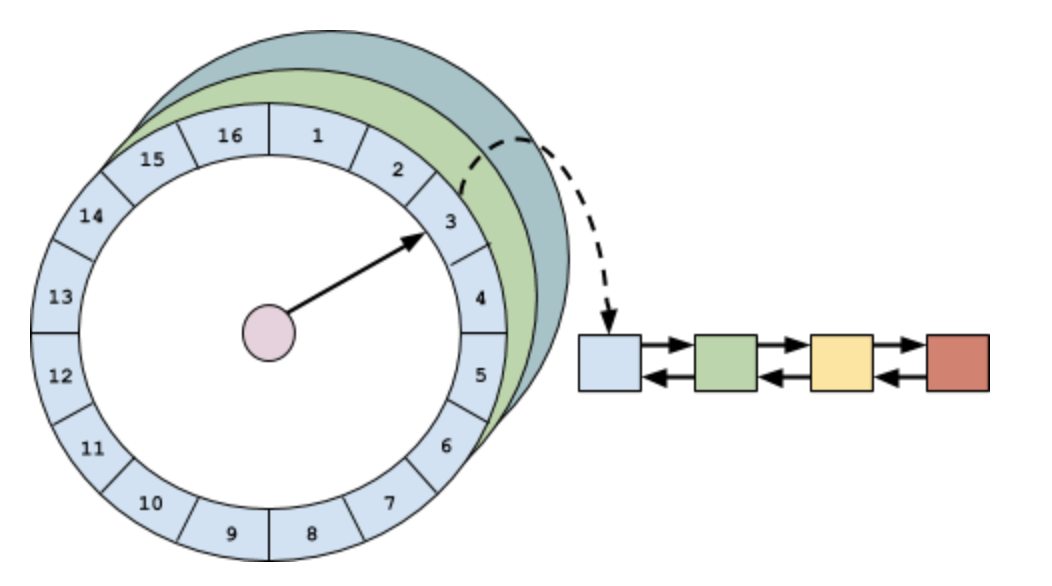
因为在我的对时间轮分析的文章里已经说了时间轮的原理和机制了,所以我就不展开 Caffeine 对时间轮的实现了。
Caffeine 对时间轮的实现在TimerWheel,它是一种多层时间轮(hierarchical timing wheels )。
看看元素加入到时间轮的schedule方法:
/**
* Schedules a timer event for the node.
*
* @param node the entry in the cache
*/
public void schedule(@NonNull Node node) {
Node sentinel = findBucket(node.getVariableTime());
link(sentinel, node);
}
/**
* Determines the bucket that the timer event should be added to.
*
* @param time the time when the event fires
* @return the sentinel at the head of the bucket
*/
Node findBucket(long time) {
long duration = time - nanos;
int length = wheel.length - 1;
for (int i = 0; i < length; i++) {
if (duration < SPANS[i + 1]) {
long ticks = (time >>> SHIFT[i]);
int index = (int) (ticks & (wheel[i].length - 1));
return wheel[i][index];
}
}
return wheel[length][0];
}
/** Adds the entry at the tail of the bucket's list. */
void link(Node sentinel, Node node) {
node.setPreviousInVariableOrder(sentinel.getPreviousInVariableOrder());
node.setNextInVariableOrder(sentinel);
sentinel.getPreviousInVariableOrder().setNextInVariableOrder(node);
sentinel.setPreviousInVariableOrder(node);
}
其他
Caffeine 还有其他的优化性能的手段,如使用软引用和弱引用、消除伪共享、CompletableFuture异步等等。
总结
Caffeien 是一个优秀的本地缓存,通过使用 W-TinyLFU 算法, 高性能的 readBuffer 和 WriteBuffer,时间轮算法等,使得它拥有高性能,高命中率(near optimal),低内存占用等特点。
参考资料
TinyLFU 论文[7]
Design Of A Modern Cache[8]
Design Of A Modern Cache—Part Deux[9]
Caffeine 的 github[10]
参考资料
Caffeine: https://github.com/ben-manes/caffeine
[2]这里: https://albenw.github.io/posts/df42dc84/
[3]Benchmarks: https://github.com/ben-manes/caffeine/wiki/Benchmarks
[4]官方API说明文档: https://github.com/ben-manes/caffeine/wiki
[5]这里: https://github.com/ben-manes/caffeine/wiki/Guava
[6]HashedWheelTimer时间轮原理分析: https://albenw.github.io/posts/ec8df8c/
[7]TinyLFU论文: https://arxiv.org/abs/1512.00727
[8]Design Of A Modern Cache: http://highscalability.com/blog/2016/1/25/design-of-a-modern-cache.html
[9]Design Of A Modern Cache—Part Deux: http://highscalability.com/blog/2019/2/25/design-of-a-modern-cachepart-deux.html
[10]Caffeine的github: https://github.com/ben-manes/caffeine

老家浙江东海边,靠海吃海,目前经营一个小品牌,让普通人吃到最新鲜的海鲜。有兴趣可以点击了解:《浙里有渔,鲜人一步!》???
往期推荐
下方二维码关注我

技术草根,坚持分享 编程,算法,架构
